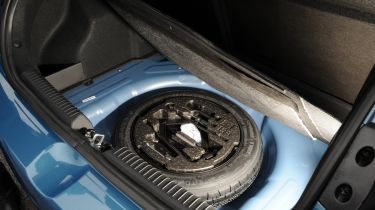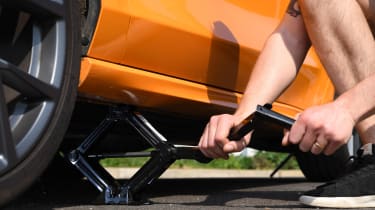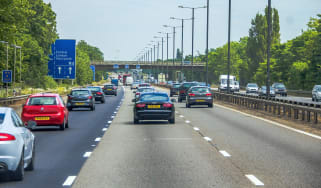How to change a tyre
Getting a puncture is inconvenient but our guide will help you change the wheel yourself

Modern cars come equipped with a tyre-pressure monitoring system that warns you when a tyre is losing air pressure. While this is a welcome change from realising your car has started leaning to one side and is making a loud dragging noise, getting a flat tyre remains a big inconvenience.
If you don’t know how to change a wheel, the inconvenience is even greater, as you’ll have to wait for roadside assistance to come and do it for you, which may cost money, too.
It’s worth noting that many cars don’t come with a spare wheel any more. Instead, manufacturers provide tyre sealant to patch up the tyre so you can get to a local tyre shop - in theory, at least. If your car doesn’t have a spare wheel, read our guide to using a puncture repair kit.
Changing a tyre is quite easy and is likely to take around half an hour or so, but there are things you should know in order to make the job as stress-free and as safe as possible. Read on to find out how to change a tyre.
Quick step-by-step guide
- Park on a flat, firm surface with the handbrake on. Passengers and spare wheel should be out of the car
- Loosen wheel nuts on affected wheel before jacking car up
- Jack up car at specific points (found in your handbook) to avoid damaging the car
- Remove loosened nuts and take wheel off
- Replace wheel, hand-tighten nuts and lower car to the ground. Fully tighten nuts once car is on the ground
Before you start
It’s important that the car is on flat ground, as having the weight of the car unevenly spread is unsafe when you’re raising it off the ground. You should put the handbrake on and put the car in gear to prevent the car from trying to roll too. It’s also important to make sure the ground under the car is firm, as you risk the weight of the car pushing the jack into the ground if it’s too soft.
What you’ll need
Your car’s manual should tell you where to find the jack (to lift the car off the ground) and the wheel brace (the tool to undo the wheel nuts). They’re most likely to be with the spare wheel under the floor of the boot, but the manual will tell you where, along with the place to put the jack so you don’t damage the underside of the car when you lift it.
The first thing to do is to loosen the wheel nuts while the wheel is still on the ground. The nuts should be obvious on alloy wheels, but if you have steel wheels, you may need to prise the plastic wheel covers off to see the fixings. If you lift the car up first, you’ll have the job of holding the wheel still while you try to loosen the nuts. The nuts are likely to be on quite tightly, in which case you’ll need the extra leverage afforded by the wheel brace to undo them initially.
Next you’ll need to get the jack and the spare wheel out of the car. It’s best to get everything you need out of the car before you lift it with the jack, so you don’t end up causing the car to rock when it’s in the air by lifting things out of it. For the same reason, don’t let passengers try to get in and out of the car when it’s on the jack, even if they’re standing outside the car getting cold.

Jacking up the car
Once you’ve checked in the manual where you should use the jack, lift the car up enough so that the wheel you’re changing is clear of the ground. If the car seems unsteady as you lift it, lower the jack again and reposition it so it’s more stable. Getting the wheel off the ground is unlikely to involve using the jack’s full travel but that’s okay; the closer the car is to the ground, the more stable it’ll be.
Replacing the wheel
When the wheel is off the ground, remove the loosened nuts completely, take the wheel off the hub and put the spare wheel onto the hub in its place. Depending on how the wheel fastens to the hub of your car, you’ll either need to put the holes of the wheel over some studs, or locate the wheel on a lip around the hub while lining up the holes on the wheel with the holes on the hub (this is if the wheel fastens with bolts rather than nuts).
Then, tighten the nuts by hand, before lowering the car on to the ground to tighten them fully with the wheel brace. After tightening one nut, tighten the one opposite to it rather than the one next to it to ensure the wheel sits on the hub properly.
Spare wheels will be marked with a maximum top speed – for many it’ll be 50mph – and you should get the punctured tyre replaced on the standard wheel as soon as possible, as the space-saver is only a temporary measure and not as safe.
Is it illegal to change a tyre on the motorway?
Even if you think you can quickly whip a flat tyre off and replace it without any drama, you should never change a tyre on the hard shoulder of the motorway. You will need to stand behind the metal barrier and call a breakdown service, and they will tow you to a safe place. Not only are you putting yourself very close to fast-moving traffic but you could be a distraction to other motorists.
How much does it cost to change a tyre?
Tyres come in lots of different sizes, and bigger tyres cost more - a powerful SUV’s fat tyres can cost three or four times as much as the skinnier tyres on a city car. Buying a replacement tyre is often an unwelcome surprise but it’s important to buy the best tyre you can afford, as the very cheapest tyres don’t generally perform as well, so aren’t as safe. Never get part-worn tyres, as you don’t know how they’ve been used. As mentioned above, you may also have to factor in the cost of having your car recovered, depending on where you break down.
Read our guides to the best tyres and best winter tyres.
Recommended

Classic car tax exemption: which historic vehicles qualify?
Most Popular

Omoda E5 targets rivals: now with zero deposit and APR

Ford Puma Gen-E driven: Electric charmer or too little, too late?
Tips & advice

Car dashboard warning lights: what does each symbol mean?

Electric car charging stations: public networks, charger types, apps and maps










